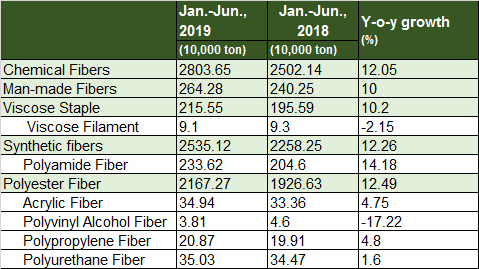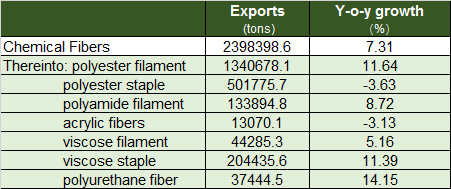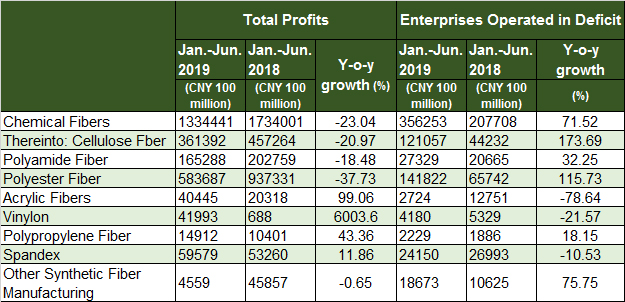2019/9/27
In the first half of 2019, China's economic environment was severely complicated, especially with increasing external challenges and uncertainties, and the downward pressure on the chemical fiber industry was increasing. In general, the demand side continued to weaken, and the contradiction between supply and demand was prominent; the profitability of the chemical fiber industry dropped significantly, while the quality of operation was generally stable, but the risk has already appeared; the integration of industrial chain further deepened, and the profit of the industrial chain was redistributed; the growth rate of investment fell back to negative growth, and the newly added capacity decreased year-on-year.
I.Basic Situation of Industry Operation
(A) Production
According to the National Bureau of Statistics, from January to June, the production of chemical fibers was about 28.03 million tons, seeing year-on-year rises of 12.05%. Among them, the growth rate of polyester fiber production, polyamide fiber production and viscose staple production both exceeded 10%.
Table 1: Chemical Fiber Production in H1,2019

Source: National Bureau of Statistics, China Chemical Fibers Association
(B) Demand
In the case of slower growth in domestic sales of textiles and apparel and a marked increase in export pressure, the end-use market is weak, and the impact of trade friction continues. Although the output of the main products of chemical fiber can still maintain the growth trend, compared with the same period of last year, the growth rate of cotton blended yarn, chemical fiber yarn, and cord fabric has decreased to varying degrees.
From the perspective of chemical fiber exports, from January to June, China's chemical fiber exports reached 2.4 million tons, up 7.31% year-on-year, 0.43 percentage points higher than the same period of the previous year. However, affected by the Sino-US trade war, China's exports of chemical fiber to the United States decreased by 37% year-on-year, its share of the total decreased 3.4 percentage points.
Table 2: Export of Chemical Fiber Products in January-June 2019

Source: Based on data from Chinese Customs
(C) Market
Taking polyester as an example, there was a willingness of the market to rebound after sharp fall in 2018. In May, the increased pressure of Sino-US trade friction has led to a rapid decline in the prices of various products in the chemical fiber market. As the trade war resumed after the G20 meeting, a short-term upswing has appeared. However, the demand did not improve substantially. In July, the price back to the downtrend channel again.
(D) Quality and Efficiency
According to the National Bureau of Statistics, from January to June, the main business income of the chemical fiber industry was CNY 428.7 billion, up 7.1% year-on-year. Its total profit reached CNY 13.3 billion, down 23% year-on-year. 26.52% of chemical fiber enterprises operated in deficit, increased 4.6 percentage points year-on-year; the loss value of these enterprises surged sharply by 71.5% year-on-year. The operating profit margin was 3.11%, down 1.22 percentage points year-on-year.
By industries, polyester industry's profits totaled CNY 5.84 billion, declined by 37.7% year-on-year; polyamide fiber industry's profits totaled CNY 1.65 billion, decreased by 18.5%.
Table 3: Economic Benefits of Chemical Fiber Industry in H1, 2019

Source: National Bureau of Statistics
II. Operation Forecast of the Annual Chemical Fiber Industry
By and large, the downward pressure on the chemical fiber industry in the second half of the year is still very large, and the risks and challenges remain. As the country's positive measures to promote high-quality development gradually implemented, it will also provide strong support for the development and operation of the chemical fiber industry, and the textile industry's own anti-risk ability and development resilience will continue to improve. The industry must focus on resolving risks, strengthening industry self-discipline, avoiding bad competition, and rationally controlling the increase in new capacity.



Authority in Charge: China National Textile and Apparel Council (CNTAC)
Sponsor: China Textile Information Center (CTIC)
ISSN 1003-3025 CN11-1714/TS
© 2025 China Textile Leader, all rights reserved.
Powered by SeekRay